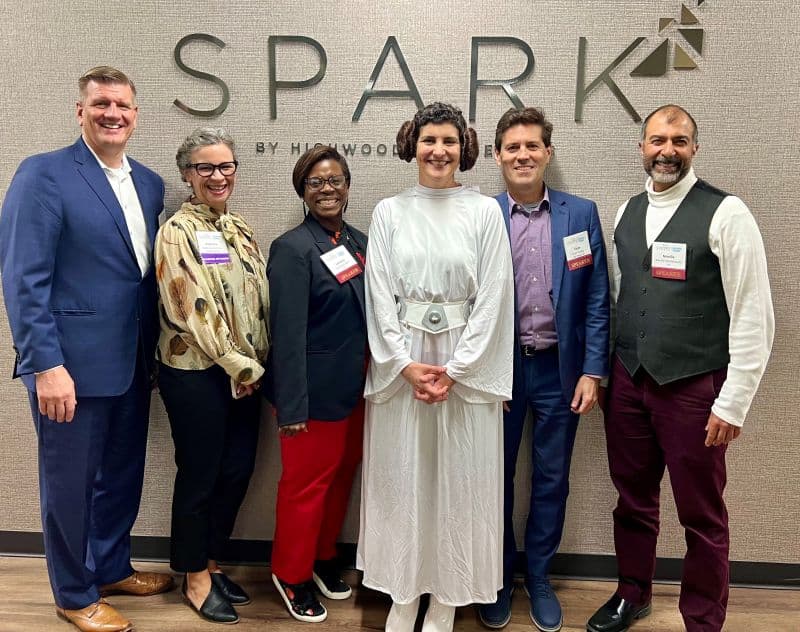With the pandemic forcing many companies to adopt a work-from-home model, the percentage of full-time remote work surged to more than 60% at its peak. This was a steep cry from 5% in 2019. While the share of remote work is slowly declining, experts predict it to likely stabilize around 25%. Still, a significant bump from pre-pandemic times.
As we blaze a new trail and navigate the future of work, we should acknowledge that much like the two sides of the Force in the Star Wars universe, remote work has its own light and dark sides.
On May 4—yes, this date was intentional—I had the pleasure of moderating a local CoreNet Global panel discussion exploring the duality of perspectives between employees and employers. The panel delved into the constantly evolving opportunities and challenges of remote work, hybrid work, and the return to office—all peppered with clever Star Wars references.

Countless moments reinforced how we are learning from each other. While remote work and hybrid work are nuanced and complex topics, there was alignment in the following five key themes.
WE CAN DO THIS. NOW WHAT?
The pandemic offered a literal global mindset shift. We saw resiliency, shared empathy, a “get it done” mentality, accelerated experimentation … and even increased profits. Corporate real estate (CRE) leaders had already acknowledged that the workplace was changing to meet the needs of the future workforce, even before the pandemic. Once the benefits of remote work became apparent, problem-solving and planning became more targeted to the unique needs of the organization and its culture.
EQUITABLE EXPERIENCES ARE NOT THE SAME
Experiences are not the same for every employee because they are based on individual needs, backgrounds, and perspectives. An equitable workplace considers and addresses the unique needs of each employee to ensure fair treatment and that everyone has an equal opportunity to succeed. Giving autonomy and allowing employees to choose how, where, and when they perform their work is feasible, despite the diversity of individual needs and preferences. Ensuring that sufficient workspace and technology are available to all employees is a prerequisite for allowing individuals to maintain autonomy.
PEOPLE ARE WHAT MATTERS
Team members are the magic ingredient to get others into the physical workplace. They also drive the programming and amenities implemented in the office environment. Other humans, a strong culture, and meaningful workplace experiences create the connective workplace tissue. One cannot overstate the value of face-to-face learning and mentorship. Workforce evolution results from intentional prioritization of onboarding, trust/relationship building, mentorship, and career development at every level.
PRODUCTIVITY WITH A CAPITAL “P”
Early pandemic days taught us that we—even as individual contributors— can be productive and achieve short-term business results, e.g., increased profit margins and output. However, there is a distinct difference between producing alone and creating, developing, and discovering together. Social capital, created through teamwork and collaboration, drives growth and success in business and careers. Collective contribution to meet company goals leads to transformation, innovation, and even revolution.
CULTURE DRIVES POLICY, NOT THE REVERSE.
Workplace culture is a crucial aspect of any organization that affects employee behavior, engagement, and overall organizational success. These values and beliefs shape policy. A targeted focus can help illuminate opportunities, gaps, and policy structures that might be overlooked. The contributions of its people make a thriving culture possible. Organizations are developing remote and hybrid work policies that welcome input from key stakeholders (HR, IT, CRE, Finance) and business partners (Tech, Design, Furniture, General Contractors) that align with their business.
Remote work, like the Force in Star Wars, can be a powerful tool for good or evil, depending on how it is used. Each panelist imparted humbled but confident wisdom on their methods for navigating this unprecedented time. There is no single solution that works for every organization. However, stakeholders must find opportunities to take an active role in defining what does fit. It is a continuous balancing act of what serves both employees and customers, requiring consistent evaluation of possibilities and barriers. By doing so, organizations can harness the power of the Force for good and avoid the pitfalls of the dark side.
Thank you to CoreNet Global Carolinas Chapter for inviting Rebecca Sistruck to moderate “The Light & Dark Side of Remote Work” panel discussion, along with the incredible panelists who shared their valuable insights: Lalonna Griffin (RTI International), Neville M. Devlaliwalla (SAS), Evan Yasskey (UNC Chapel Hill), and Lou Gregus (Fidelity Real Estate/Fidelity Investments). A special shoutout to the CoreNet Global Carolinas Chapter event planning team: Jessica Pearson (Gensler), Melissa Carter (IA), Nicole Kalafut (PMC), Matt Racher (Autodesk), and Jay Maag (JLL).

